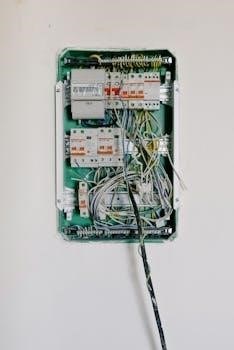
RV Wiring Guide⁚ A Comprehensive Overview
Unlock the secrets of your RV’s electrical system with our comprehensive guide! We’ll demystify RV wiring, covering essential components and functions to empower your mobile home adventures. From fundamental principles to practical knowledge, confidently navigate your RV’s electrical setup.
Understanding RV Electrical Systems
RV electrical systems can seem complex, but understanding the basics is crucial for safety and functionality. Think of your RV as a mini-house on wheels, requiring both AC and DC power to operate appliances, lights, and other devices. AC power, like that in your home, runs high-voltage appliances when connected to shore power or a generator. DC power, typically from batteries, powers low-voltage items and is essential for off-grid camping.
The RV electrical panel acts as the central distribution point, managing both AC and DC currents with breakers and fuses. Wiring and cabling are the lifelines, carrying electricity throughout the RV; proper installation and insulation are vital. Whether you’re a seasoned RVer or a newbie, grasping these fundamentals empowers you to troubleshoot issues and make informed decisions about your RV’s electrical needs.
AC vs. DC Power in RVs
Understanding the difference between AC and DC power is fundamental to mastering RV electrical systems. AC, or Alternating Current, is the type of power you get from shore power connections at campgrounds or from a generator. It’s characterized by a current that reverses direction periodically, typically 60 times per second in the US. AC power runs high-voltage appliances like air conditioners, microwaves, and TVs.
DC, or Direct Current, flows in one direction, usually supplied by your RV’s batteries. DC power is used for low-voltage devices like lights, water pumps, and some electronics. A converter charger transforms AC power into DC power to charge the batteries and operate DC appliances when shore power is available. Understanding how these two power systems interact is key to efficient and safe RV electrical management.
Common RV Wiring Services⁚ 20, 30, and 50 Amp
RVs utilize different amperage services to cater to varying power demands. The most common RV wiring services are 20-amp, 30-amp, and 50-amp. 20-amp service is typically found in smaller campers and trailers, providing limited power for basic appliances and lighting. 30-amp service is more common in medium-sized RVs, offering sufficient power for running essential appliances like a single air conditioner and a refrigerator.
Larger RVs with multiple air conditioning units and more appliances generally require a 50-amp service. This provides a substantial amount of power, allowing for simultaneous use of multiple high-demand devices. When connecting to shore power, it’s crucial to match your RV’s wiring configuration with the appropriate receptacle to avoid overloading the system and causing damage. Understanding these service types is essential for safe and efficient power usage in your RV.

Key Components of an RV Electrical System
An RV’s electrical system relies on key components working together. These components include the electrical panel, wiring, cabling, breaker panel, and converter charger, ensuring safe and reliable power distribution.
RV Electrical Panel⁚ AC and DC Distribution
The RV electrical panel serves as the central hub for managing both AC (Alternating Current) and DC (Direct Current) power within your recreational vehicle. Typically located in an accessible, yet somewhat obscure spot, this panel is the junction box housing fuses and breakers for the entire electrical system. The panel’s design allows for the distribution of AC power, primarily used when connected to shore power, to operate appliances like air conditioners and microwaves. Simultaneously, it manages the DC power, often supplied by batteries, which supports lighting, water pumps, and other essential RV functions.
Understanding how your RV electrical panel distributes AC and DC current is an important step. This ensures the safe and efficient operation of all electrical components. Regular inspection and maintenance of the panel are crucial for preventing overloads and ensuring the longevity of your RV’s electrical system.
Wiring and Cabling⁚ Types and Safety
Wiring and cabling within an RV are crucial for carrying electricity from the power source to devices and appliances. Selecting the correct wire type and gauge for each circuit is essential for safety and efficiency. Common wire types include stranded copper wire, known for its flexibility, and different insulation materials rated for specific temperature and voltage requirements. RV electrical wires commonly run along the RV’s frame from the main distribution points and the battery. From here they run up into the walls to appliances, lights, and outlets.

Safety is paramount when dealing with RV wiring. Ensure all wiring is properly installed, insulated, and protected to prevent electrical hazards. Regular inspections should be conducted to check for wear, damage, or loose connections. When working on electrical systems, always disconnect from the power source and follow safety protocols to prevent electrical shock or fire. Understanding the basics of RV wiring can save you time and money when it comes to troubleshooting and making repairs.
120-Volt Breaker Panel and Converter Charger
The 120-volt breaker panel serves as the central distribution point for AC power within your RV. Similar to a home electrical panel, it divides the incoming power into individual circuits, each protected by a circuit breaker. These breakers safeguard against overloads and short circuits, preventing damage to appliances and wiring. Ensuring properly sized breakers for each circuit is critical for safe operation.
The converter charger plays a vital role in maintaining your RV’s 12-volt DC system. When connected to shore power, the converter charger transforms 120-volt AC power into 12-volt DC power, which is then used to charge your batteries and power DC appliances. This ensures that your batteries remain charged and ready for use, even when you’re not connected to an external power source. The 120-volt breaker panel distributes power to 120-volt devices and connects to the converter charger.

Essential Wiring Diagrams and Resources
Comprehensive wiring diagrams are essential for understanding and troubleshooting your RV’s electrical system. These diagrams provide a roadmap to trace circuits and ensure safe, reliable repairs and modifications. Resources abound for finding diagrams specific to your RV model.
Importance of RV Wiring Diagrams
RV wiring diagrams are indispensable tools for anyone working with or maintaining an RV’s electrical system. They act as a visual roadmap, illustrating how all electrical components are connected and how power flows throughout the vehicle. This understanding is crucial for troubleshooting issues, performing repairs, and making modifications safely.
Without a diagram, tracing wires and identifying connections becomes a time-consuming and potentially hazardous task. A wiring diagram allows you to quickly pinpoint the source of a problem, such as a faulty circuit or a loose connection. This saves time and reduces the risk of electrical shock or damage to the system.
Moreover, wiring diagrams are essential for ensuring that any repairs or modifications are done correctly. They provide a reference point for verifying that new components are wired properly and that the overall system remains safe and functional. Whether you’re a seasoned RVer or a novice, having access to accurate wiring diagrams is vital for maintaining a reliable and safe electrical system.
Finding Wiring Diagrams for Specific RV Models
Locating wiring diagrams for specific RV models can sometimes be a challenge, but several resources can prove helpful. Start by checking the RV manufacturer’s website or contacting their customer service department. They may have diagrams available for your specific model, either as downloadable files or printed documents.
Online RV forums and owner groups are another valuable source. Members often share diagrams and other technical information related to their RV models. You can also try searching online databases and libraries that specialize in technical documents and schematics.
Another option is to consult with an RV repair shop or technician. They may have access to a library of wiring diagrams and can provide you with a copy for your specific model. Be prepared to provide the RV’s make, model, and year to help them locate the correct diagram.
Remember that RV wiring can vary significantly between models, so it’s crucial to obtain a diagram that matches your specific RV to ensure accurate and safe electrical work.

Safety Precautions for RV Electrical Work
Working with electricity in an RV can be dangerous if proper safety precautions are not followed. Before starting any electrical work, always disconnect the RV from all power sources, including shore power and generators. Double-check that the power is off using a non-contact voltage tester.
Wear appropriate personal protective equipment (PPE), such as insulated gloves and safety glasses, to protect yourself from electrical shock and arc flashes. Use tools with non-conductive handles to minimize the risk of electrical contact.
Never work on electrical systems in wet or damp conditions, as water can increase the risk of electrocution. If you are not comfortable working with electricity, it is best to consult a qualified RV technician.
When replacing wires or components, use the correct gauge and type of wiring for the application. Ensure that all connections are secure and properly insulated to prevent short circuits and electrical fires. Always follow the manufacturer’s instructions and local electrical codes when performing any electrical work on your RV. Remember, safety should always be your top priority.